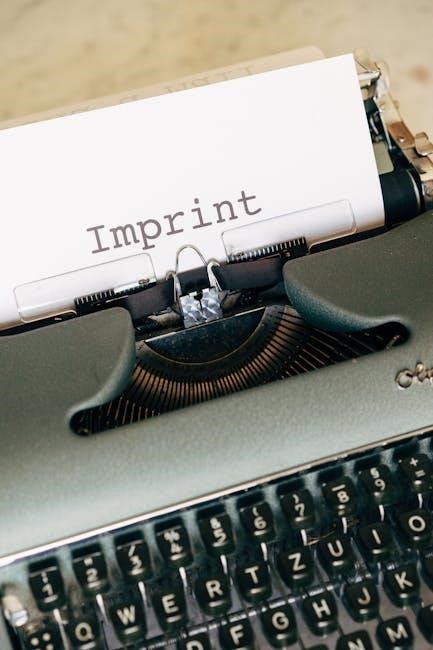Manual card imprint is a traditional method in cardiology, capturing the heart’s electrical activity through physical imprints. It aids in diagnosing various conditions, offering a tactile record for analysis, complementing modern diagnostic tools with its unique approach.
1.1 Overview of Manual Card Imprint
Manual card imprint is a traditional technique used to capture the heart’s electrical activity by creating physical imprints on paper. This method involves placing electrodes on the skin to record electrocardiogram (ECG) signals, which are then transferred onto a card. It is a simple, non-invasive process that provides a tactile record of cardiac rhythms. The imprints are analyzed to identify patterns, aiding in the diagnosis of heart conditions such as arrhythmias or conduction disorders. Despite advancements in digital ECG, manual card imprint remains valuable for its portability and ability to provide immediate, interpretable results in clinical settings.
1.2 Importance of Manual Card Imprint in Cardiology
Manual card imprint holds significant value in cardiology as a reliable method for recording and analyzing heart activity. It provides a tangible, immediate record of cardiac rhythms, enabling quick diagnosis and monitoring of conditions like arrhythmias. This technique is particularly useful in remote or resource-limited settings where advanced digital tools may not be available. Additionally, it serves as a valuable educational tool for training healthcare professionals in ECG interpretation. The tactile nature of manual imprints allows clinicians to better understand complex cardiac patterns, making it a complementary tool to modern diagnostic practices. Its simplicity and accessibility ensure its continued relevance in contemporary cardiology.

History and Evolution of Manual Card Imprint

Manual card imprint traces its origins to early ECG analysis, evolving from primitive tracing methods to refined techniques. Its development paralleled advancements in cardiology, shaping modern diagnostics.
2.1 Origins of Manual Card Imprint in ECG Analysis
Manual card imprint emerged alongside the early development of electrocardiography (ECG) in the late 19th and early 20th centuries. It involved capturing the heart’s electrical activity through physical imprints, providing a tangible record for analysis. This method complemented the first ECG machines, offering a straightforward way to document cardiac rhythms. Although it has largely been replaced by digital systems, manual card imprint remains a historical cornerstone in cardiology, illustrating the transition from analog to digital recording techniques and the evolution of diagnostic practices.
2.2 Key Milestones in the Development of Manual Card Imprint
The development of manual card imprint in ECG analysis involved significant advancements. One major milestone was the invention of the first practical electrocardiograph by Willem Einthoven in 1903, which laid the groundwork for recording heart activity. Another key development was the refinement of imprinting techniques, allowing for clearer and more accurate representations of cardiac rhythms. The introduction of standardized methods for interpreting imprints further enhanced their diagnostic value. Additionally, advancements in materials, such as specialized papers and inks, improved the durability and readability of manual imprints. These milestones collectively established manual card imprint as a reliable tool in early cardiology, bridging the gap between analog and digital recording methods.

Technique and Methodology
Manual card imprint involves a systematic process of capturing heart activity using physical contact, requiring precision and specialized tools to ensure accurate and reliable ECG recordings.
3.1 Step-by-Step Guide to Performing a Manual Card Imprint
Performing a manual card imprint involves several precise steps. First, prepare the patient by ensuring skin cleanliness and proper electrode placement. Next, position the card or paper on the chest wall, aligning it with the heart’s electrical axis. Apply gentle pressure using a specialized tool or the fingertips to capture the cardiac impulses. Ensure good contact to minimize interference and obtain clear imprints. Record the tracing for an adequate duration to capture representative heart activity. Finally, label the imprint with patient details and the date for accurate documentation and interpretation. This method requires skill and attention to detail to ensure reliable results.
3.2 Materials and Tools Required for Manual Card Imprint
The manual card imprint technique requires specific materials, including a specially designed card or high-quality paper to capture the imprint. A stylus or similar blunt tool is used to apply pressure and transfer the electrical signals. Conductive electrodes or gels may be applied to enhance signal clarity. A measuring tool, such as a ruler, is essential for accurate electrode placement. Additionally, reference electrodes are needed to ensure proper signal capture. A recording device or chart paper is used to document the tracings. Cleaning supplies and a stable surface are also necessary to maintain hygiene and precision. These materials collectively ensure a clear and accurate manual card imprint.
3.3 Preparing the Patient for Manual Card Imprint
Preparing the patient for a manual card imprint involves several key steps to ensure accuracy and comfort. The skin surface must be cleaned to remove oils or lotions, and excess hair may need to be shaved for better electrode adhesion. The patient should be positioned comfortably, typically lying down, to minimize movement during the procedure. It is essential to explain the process to reduce anxiety and ensure cooperation. The patient should remain still and avoid speaking during the imprint to prevent interference. Jewelry or metal objects that could interfere with the signal should be removed. Proper preparation ensures clear and reliable results.
3.4 Interpretation of Manual Card Imprint Results
Interpreting manual card imprint results involves analyzing the imprinted patterns on the card to identify electrical activity. Skilled practitioners examine waveform shapes, amplitudes, and intervals to detect abnormalities. The imprints are compared to normal traces to diagnose conditions like arrhythmias or hypertrophy. Accurate interpretation requires knowledge of ECG basics and clinical context; Errors in interpretation can lead to misdiagnosis, emphasizing the need for expertise. The results are often cross-verified with symptoms and other diagnostic tools to ensure reliability. Proper interpretation is crucial for guiding treatment decisions and improving patient outcomes.

Applications of Manual Card Imprint
Manual card imprint aids in diagnosing heart conditions and is valuable in cardiology studies, serving as a reliable tool for both clinical and research purposes effectively.
4.1 Clinical Applications in Diagnosing Heart Conditions
Manual card imprint is a valuable tool in clinical settings, aiding in the diagnosis of heart conditions such as arrhythmias, ischemia, and conduction abnormalities. By capturing the heart’s electrical activity, it provides a physical record for detailed analysis, helping cardiologists identify patterns and irregularities. This method is particularly useful in situations where modern digital tools may not be readily available, ensuring timely and accurate diagnoses; Its tactile nature allows for a comprehensive understanding of cardiac function, making it a reliable complement to modern diagnostic techniques in clinical practice.
4.2 Research Applications in Cardiology Studies
Manual card imprint serves as a valuable resource in cardiology research, enabling detailed analysis of heart activity for studies on arrhythmias, ischemic patterns, and cardiac anomalies. Its tactile nature allows researchers to track subtle changes over time, facilitating long-term studies and historical comparisons. The method also supports reproducibility, as physical imprints provide consistent data for cross-study analysis. Researchers can collaborate effectively by sharing imprints, enhancing collective understanding of cardiac conditions. Additionally, manual card imprint aids in training future cardiologists by providing a tangible learning tool. Its simplicity makes it ideal for studies in resource-limited settings, ensuring accessibility and contributing to global cardiology advancements.

Advantages of Manual Card Imprint
Manual card imprint offers accuracy, cost-effectiveness, and a non-invasive approach, making it a reliable tool in cardiology. It provides a tactile record for precise analysis and is accessible in resource-limited settings.
5.1 Accuracy and Reliability in ECG Readings
Manual card imprint ensures high accuracy and reliability in ECG readings by capturing the heart’s electrical activity with precision. The tactile nature of the imprint allows for detailed analysis, often detecting subtle patterns that digital methods might miss. Skilled practitioners can interpret imprints with consistency, reducing variability in results. This method complements digital ECGs, offering a reliable alternative when advanced technology is unavailable. Its simplicity and direct representation of cardiac signals make it a trustworthy tool in cardiology, particularly for confirming diagnoses or monitoring conditions over time; The manual approach remains a vital, dependable technique in both clinical and research settings.
5.2 Cost-Effectiveness of Manual Card Imprint
Manual card imprint is a cost-effective method in cardiology, requiring minimal equipment and resources. It eliminates the need for expensive digital devices, making it accessible in resource-limited settings. The procedure involves basic tools like paper and ink, significantly reducing costs compared to modern digital ECG systems. This affordability makes it a practical choice for routine check-ups and long-term monitoring. Additionally, manual imprints can be stored without special requirements, lowering storage costs. Its cost-effectiveness ensures that high-quality cardiac care is accessible to a broader population, particularly in regions with limited financial resources. This method remains a valuable, economical option in contemporary healthcare.
5.3 Non-Invasive Nature of the Procedure
Manual card imprint is a non-invasive procedure, making it a gentle and risk-free method for patients. It does not require inserting electrodes or devices into the body, minimizing discomfort and potential risks. This approach is particularly beneficial for vulnerable patients, such as the elderly or those with sensitive skin conditions. The non-invasive nature ensures minimal stress and anxiety for individuals undergoing the procedure. By avoiding direct contact with internal tissues, manual card imprint reduces the risk of complications or infections. This method is ideal for initial assessments or frequent monitoring, offering a safe and patient-friendly alternative in cardiology diagnostics.

Limitations of Manual Card Imprint
Manual card imprint is time-consuming, requiring skill and precision, and prone to human error. Limited availability of trained practitioners further restricts its widespread application in clinical settings.
6.1 Time-Consuming Nature of the Process
Manual card imprint is a labor-intensive procedure that requires significant time to execute accurately. The process involves multiple steps, including patient preparation, imprint creation, and result interpretation, which can delay diagnosis. Unlike digital ECG methods, manual imprinting relies on physical tools and skilled technicians, making it less efficient in fast-paced clinical environments. Additionally, the tactile nature of the process demands careful handling to avoid errors, further extending the time required. This limitation makes it less practical for situations where rapid results are critical, highlighting the need for skilled practitioners to balance accuracy with efficiency in manual card imprint procedures.
6.2 Potential for Human Error in Interpretation
Manual card imprint interpretation is highly susceptible to human error, as it relies on the technician’s skill and experience. Variations in imprint quality, such as faint or smudged markings, can lead to misinterpretation. Additionally, the subjective nature of visual analysis increases the likelihood of errors, especially when identifying complex patterns. Even experienced practitioners may misread subtle abnormalities, potentially leading to incorrect diagnoses. Furthermore, factors like fatigue or environmental distractions can impair concentration, further elevating the risk of mistakes. This underscores the importance of rigorous training and standardized protocols to minimize errors and ensure accurate interpretations of manual card imprints.
6.3 Limited Availability of Skilled Practitioners
The limited availability of skilled practitioners proficient in manual card imprint poses a significant challenge. As digital methods dominate, fewer professionals are trained in this traditional technique, reducing expertise. This scarcity affects healthcare settings, particularly in rural or underserved areas, where access to specialists may be limited. The complexity of manual imprint interpretation requires extensive practice and experience, further narrowing the pool of capable practitioners. This shortage underscores the need for enhanced training programs and education to preserve and promote this valuable skill in cardiology practice.

Comparison with Digital ECG Methods
Manual card imprint differs from digital ECG in its reliance on physical interpretation, while digital methods offer faster, more accurate results, though lacking tactile feedback.
7.1 Differences in Accuracy Between Manual and Digital Methods
Manual card imprint and digital ECG methods differ significantly in accuracy. Digital ECG uses advanced algorithms to process signals, reducing human error and providing precise measurements. In contrast, manual imprint relies on human interpretation, which can lead to variability. Digital systems automatically filter noise and artifacts, ensuring clearer results, while manual methods depend on the practitioner’s skill. Studies show digital ECG is more accurate in detecting subtle abnormalities, such as minor arrhythmias or ischemic changes. However, manual imprints offer a tactile experience, allowing practitioners to sense nuances that digital methods might miss. Overall, digital ECG is generally more reliable, though manual techniques retain value in specific clinical contexts.

7.2 Advantages of Digital ECG Over Manual Card Imprint
Digital ECG offers several advantages over manual card imprint, primarily in speed and efficiency. Digital systems provide immediate, high-resolution results, reducing the time needed for analysis. They also minimize human error by automating measurements and interpretations. Digital ECG allows for easy storage and retrieval of patient data, enabling better record-keeping and longitudinal tracking. Additionally, digital systems can perform real-time monitoring, which is critical in emergency situations. They are also more cost-effective in the long term, as they reduce the need for physical materials and labor-intensive processes. Furthermore, digital ECG integrates seamlessly with electronic medical records, enhancing workflow efficiency and patient care.
7.3 Situations Where Manual Card Imprint is Preferred
Manual card imprint remains preferable in specific scenarios, particularly in remote or resource-limited settings where digital ECG devices are unavailable. It is also useful in emergency situations requiring quick, bedside assessments without relying on technology. Additionally, manual imprints are favored for teaching purposes, as they help trainees develop interpretive skills through tactile engagement. Some clinicians prefer manual methods for their simplicity and the ability to directly observe subtle patterns. Furthermore, manual card imprints are cost-effective for short-term or one-time use, making them ideal for fieldwork or low-budget clinics. They also provide a reliable backup when digital systems fail or are inaccessible.

Future Directions and Innovations
Future innovations may integrate manual card imprint with digital tools, enhancing accuracy and accessibility. Advances in training and technology could revive its relevance in modern cardiology practices.
8.1 Integration of Manual Card Imprint with Modern Technology
The integration of manual card imprint with modern technology could revolutionize its application in cardiology. By digitizing the imprint process, healthcare providers can combine tactile data with digital analysis tools, enhancing diagnostic precision. AI-driven algorithms could interpret imprints alongside ECG readings, offering a comprehensive view of heart activity. This fusion might also enable real-time monitoring and remote consultations, making manual card imprint more accessible. Additionally, integrating manual techniques with electronic health records could streamline patient data management. This blend of traditional methods and advanced technology could redefine the role of manual card imprint in contemporary cardiology, ensuring its relevance in a rapidly evolving medical landscape.
8.2 Potential for Automation in Manual Card Imprint
The potential for automation in manual card imprint lies in leveraging advanced tools like robotic arms and AI-driven sensors. These technologies could replicate the precision of human touch, enabling consistent and reproducible imprints. Automated systems might also incorporate real-time data processing, reducing the need for manual interpretation. This could minimize human error and enhance the speed of diagnosis. Furthermore, automation could standardize the imprint process, ensuring uniformity across different practitioners. By integrating automation, manual card imprint could become more efficient and accessible, particularly in high-volume clinical settings. This innovation could bridge the gap between traditional techniques and modern demands for precision and scalability in cardiology.
8.3 Advancements in Training and Education for Manual Card Imprint
Advancements in training and education for manual card imprint focus on enhancing practitioner skills through innovative learning tools. Virtual simulations and AI-driven platforms now allow trainees to practice and refine their techniques digitally. These tools provide real-time feedback, improving precision and consistency. Additionally, standardized training programs are being developed to ensure uniformity in methodology. Workshops and online courses are becoming more accessible, enabling practitioners to update their knowledge. Collaborative learning environments also foster the exchange of best practices. These advancements aim to address the shortage of skilled practitioners and ensure the technique remains relevant in modern cardiology, blending tradition with cutting-edge educational approaches for better patient outcomes.
Manual card imprint remains a valuable, non-invasive method in cardiology, offering unique insights into heart function. Despite advancements in digital tools, its tactile approach provides irreplaceable benefits, ensuring its continued relevance in modern diagnostics and research.
9.1 Summary of Key Points
Manual card imprint is a traditional, non-invasive method in cardiology, offering unique tactile insights into heart function. It involves capturing electrical activity through physical imprints, providing a complementary approach to modern diagnostics. The technique requires skilled practitioners and simple tools, making it cost-effective and accessible. While it offers accuracy and reliability, its time-consuming nature and potential for human error are notable limitations. Despite these challenges, manual card imprint remains relevant in both clinical and research settings, particularly where modern technology is unavailable. Its enduring value lies in its simplicity and ability to provide tangible records for analysis, ensuring its continued use alongside digital advancements.
9.2 Final Thoughts on the Role of Manual Card Imprint in Modern Cardiology
Manual card imprint remains a valuable, albeit niche, tool in modern cardiology, bridging traditional and contemporary diagnostic methods. Its non-invasive nature and cost-effectiveness make it particularly useful in resource-limited settings. While digital ECGs offer superior speed and accuracy, manual imprint provides a tactile record that can complement digital findings. Despite its time-consuming process and potential for human error, the technique holds historical significance and practical relevance. As cardiology evolves, manual card imprint may see integration with modern technology, ensuring its continued utility. Ultimately, it serves as a reminder of the importance of balancing innovation with established methods in patient care.
